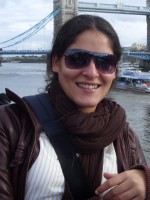resumo
In order to increase flexibility in tailoring the permeability and selectivity of supported ionic liquid membranes (SILMs) for flue gas separation and natural gas purification, this work explores the use of ionic liquid mixtures. For that purpose, gas permeation properties of CO2, CH4 and N-2 in several binary ionic liquid mixtures based on a common cation ([C(2)mim](+)) and different anions such as bis(trifluoromethyl-sulfonyl) imide ([NTf2](-)), acetate ([Ac](-)), lactate ([Lac](-)), dicyanamide ([DCA](-)) and thiocyanate ([SCN](-)) were measured at 293 K using a time-lag apparatus. In addition to gas permeation results, the thermophysical properties of those mixtures, namely viscosity and density, were also determined so that trends between the two types of properties could be evaluated. The results show that mixing [Ac](-) or [Lac](-) with [NTf2](-) promotes the decrease of gas permeability and diffusivity of the SILMs based on those binary mixtures, essentially due to their high viscosities. The pure ionic liquids containing anions with nitrile groups, [DCA](-) or [SCN](-), and also their mixtures with [C(2)mim][NTf2] exhibit permselectivities ranging from 19.1 to 23.0 for CO2/CH4, and from 36.6 to 67.8 for CO2/N-2, as a consequence of a reduction in the CH4 and N-2 permeabilities, respectively. Furthermore, it is shown that mixing anions with different chemical features allows variations in ionic liquid viscosity and molar volume that impact the gas permeation properties of SILMs, offering a clear pathway for the optimization of their CO2 separation performances.
palavras-chave
OF-THE-ART; CARBON-DIOXIDE; CO2/N-2 SEPARATION; MIXED-GAS; TEMPERATURE; SOLUBILITY; PERFORMANCE; IMIDAZOLIUM; DIFFUSIVITY; CAPTURE
categoria
Chemistry
autores
Tome, LC; Patinha, DJS; Freire, CSR; Rebelo, LPN; Marrucho, IM
nossos autores
agradecimentos
Liliana C. Tome is grateful to FCT (Fundacao para a Ciencia e Tecnologia) for her PhD research grant (SFRH/BD/72830/2010). Isabel M. Marrucho acknowledges FCT/MCTES (Portugal) for a contract under Programa Ciencia 2007. This work was partially supported by FCT through the projects PTDC/EQU-FTT/116015/2009, Pest-OE/EQB/LA0004/2011 (ITQB) and Pest-C/CTM/LA0011/2011 (CICECO).



